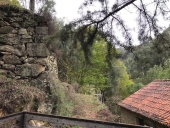

Burl Smith wrote:In my opinion you need a gate at the top to stop the flow when the water level drops and the pipe starts sucking air.
An inexpensive bilge pump AND a bilge pump float valve (situated conveniently) will do, with the 'T' at the top to prevent passive siphoning.
John C Daley wrote:Where is the air getting into the system?
An air valve at the highest point of the pipe system may be needed.
Look at 'design and 'construction of city water supply pipelines'.
If an air bubble is created in the high point, that fills the whole pipe, flow may stop, and air valve allows that air to evacuate the pipe.

Glenn Herbert wrote:From the Google pictures, it looks like the existing wall has a reasonable amount of batter (slope back of the face), and the unstable section starts a meter or more up from the flat. How much actual setback is there from the edge of the flat terrace to the wall face a meter or so up? I would measure the meter of new base thickness from that upper point, which may give you enough clearance for access on the terrace.

Glenn Herbert wrote:From the Google pictures, it looks like the existing wall has a reasonable amount of batter (slope back of the face), and the unstable section starts a meter or more up from the flat. How much actual setback is there from the edge of the flat terrace to the wall face a meter or so up? I would measure the meter of new base thickness from that upper point, which may give you enough clearance for access on the terrace.

Kenneth Elwell wrote:Rich, you could possibly start the siphon by pumping some water back to the stream from tank A to refill the pipe. This might require some clever plumbing with bypass valves, but ought to work as long as tank A doesn't run dry.
Seems like metering your supply from the stream to match your usage, would allow the siphon to just run constantly and *never* break, require re-priming it?
If you had excess flow at tank A could you use it? or return it back to the stream farther downhill? (return of excess would negate need for metering)
If you could pump excess water to tank B, could it irrigate "automatically"? using swales or such? (tank B would then be a reserve)

Glenn Herbert wrote:If you have enough space at the bottom of the wall to build a substantial new wall, and can get new stones without difficulty, I think that would be a good solution.
It would be important to have the toe of a new 2 meter high wall at least 1 meter out from the toe of the unstable wall, and the face of the new wall sloping back at least 1 in 6 (or 1/3 of a meter), and all the new stonework bedded so that they want to slide back into the hill. I would carry the new wall up until it supports the unstable section, such that the exposed upper part of the old wall is not in danger of collapsing.
With that done, I don't think you would need to do anything else to the old wall aside from filling gaps to make it look better. This course of action would avoid the work and hazard of dismantling the old wall. Can you get new stone delivered to the bottom area and stockpiled with working space?

Dean Howard wrote:Sounds like a "ram pump" is what you need. If you have good enough flow in your stream, it will pump water uphill just fine, no electricity needed. I saw one on homestead rescue where they pumped uphill with only stream power.
